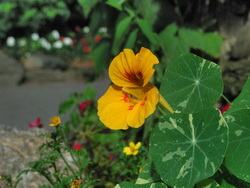Nasturtium Seeds
Many people have come to realize the wonderful flavor found within nasturtium flowers and leaves. Many do not know however that nasturtium seeds are also edible and very flavorful. They are used in many instances to replace capers and there are many recipes that allow you to pickle these seeds yourself for use on a variety of different dishes. The seeds are fairly large which makes them perfect for pickling and very easy to handle if you are planning to plant yourself a nasturtium garden. Because of their size, nasturtium seeds need to be planted about ten to fifteen inches apart to allow for proper growth of the flowers.
Pickling Seeds
Nasturtium seeds are rich in iron and Vitamin C and make an excellent addition to salads and other wholesome foods. When pickling, the seeds should be picked while they are still fresh and green. Pick them leaving a very short length of the stem and soak in cold water with a bit of salt added. Soak for two days and then rinse and soak for an additional day in plain cold water. Drain and place the seeds in a glass jar and cover with heated vinegar to the top of the jar. Replace the lid tightly and in just a few days you will have a wonderful jar of pickled nasturtium seeds ready to be used on a variety of salads, pizza, smoked salmon or just on a toasted bagel with cream cheese. There are many recipes that call for these delicious seeds or you can simply add them to your favorite dish and make your own unique recipe.
Planting Nasturtium Seeds
If you are planning to use your nasturtium seeds to begin your own nasturtium garden, remember to place each large seed no less than ten inches apart. They should be placed about a half an inch below the surface of the soil. Nasturtiums are an excellent flower for beginning gardeners and children because they grow virtually anywhere and with little care. There are no preparations needed to the soil prior to planting. You simply have to push the seeds into the soil, ensuring that they are at least half an inch below the surface. They should begin to germinate in around a week or so. The flowers themselves can be found in a variety of species and colors that range from creams and pastels to bright oranges and reds. Be sure that you plant them in an area that gets good drainage and that receives full sunlight for best growth.
Best Soil for Growing
Nasturtiums actually do not need rich soil. In fact, they prefer dry soil that is not overly fertilized. They grow fairly well on their own without any help so there is no need for compost, fertilizers or mulch to help them along. Plant them beside other plants as they make excellent companions and will help to repel cucumber beetles and squash vine borers because of their peppery leaves. The entire plant is edible from the seeds to the leaves and flowers and gives a spicy flavor to virtually any dish.
